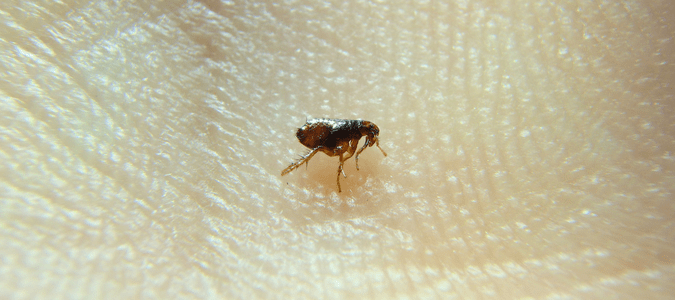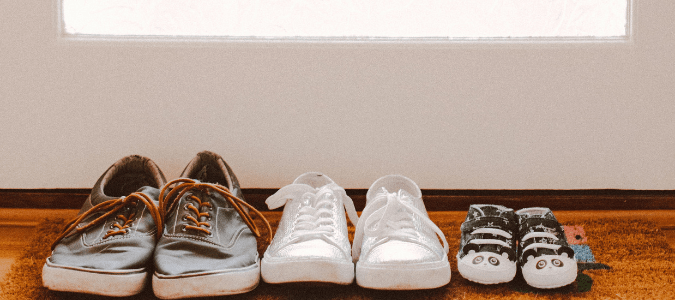
Even after putting the flea collar on your pet, the itching continues. Suddenly, you begin to feel the urge the scratch, too. You stare at poor Fido, who looks quite miserable, and start to wonder, can fleas lay eggs on human hair? If these creatures can infest your dog’s fur, wouldn’t it make sense that they could do the same on our own heads?
While fleas can technically lay eggs on our scalp, the possibility of this happening is extremely rare. Given how much these small parasites can disrupt a household, however, knowing all you can about fleas can help you avoid an infestation or manage an existing flea problem.
Let’s answer more questions homeowners frequently have about these common pests.
Can Fleas Live On Humans?
While humans can serve as a temporary host for fleas, eggs are more viable if a flea consumes the blood of a preferred food source. There are over 2,000 different types of fleas, some of which feed on dog blood, while others consume cat blood. Only one species, the Pulex irritans, requires human blood to survive. Luckily, it’s unlikely you’ll come across this species in the United States, as human fleas are often not found in developed countries.
The most common type of flea is a cat flea (Ctenocephalides felis), which, as you might expect, feeds on cats, as well as dogs. Dog fleas (Ctenocephalides canis) can infest cats, opossums, raccoons, livestock and, of course, dogs. The Oriental rat flea (Xenopsylla cheopis) prefers rats, but can also consume the blood of dogs and cats.
Most of the time, fleas use human hair and skin as a mode of transportation—not a permanent living space. Even when these creatures are starved of cat or dog blood and have to settle with feeding on us, fleas still don’t spend most of their time on us, as they do on our pets.

Can Humans Get Fleas From Cats And Dogs?
Humans can certainly get flea bites from interacting with cats and dogs. In the same way that fleas can move from pet to pet or from animal to animal, these creatures can also move from a cat or a dog to a human. As a matter of fact, it’s not uncommon for a pet owner (or child) who sleeps in the same bed as an infected dog or cat to end up with irritating, red bites.
Most fleas who invade your home are in search of a cat or dog—not you. The only reason fleas will bother humans is if they become very hungry if their preferred host is unavailable. For example, let’s say a recent high school graduate takes the family dog to college. Those starved fleas that had been infesting the resident pooch will be looking for any source of blood they can find, which will likely be you.

Can Fleas Live On Furniture?
To properly understand whether fleas can reside on our couches, beds and recliners, you have to understand the life cycle of a flea. When female fleas get their needed blood meal, they will lay their eggs, usually in an animal’s fur while it is sleeping or resting. These eggs usually fall off the host during normal activities, whether by scratching, grooming or generally moving around.
These eggs could also become dislodged when your pet jumps off the couch or another piece of furniture. Eggs will hatch into larvae three or four days later. Larvae will survive off predigested blood from their mother. These immature fleas hate light and will burrow into your carpet, couch or even your bed to avoid it.
When the flea larvae mature, they spin themselves into a cocoon. During this egg to cocoon period, these immature fleas can live in your furniture.
These pupae won’t hatch from their cocoons until they feel the thermal heat of a host or until they are cracked open by the pressure of someone (or something) walking around. Once the adult fleas hatch, they will hop right onto the closest host they find and will seek a blood meal.
Because adult fleas only live for about a week or two, you may think that you can just wait it out and avoid rooms and furniture that may be infested with fleas and flea eggs, but, unfortunately, that’s not the case. Female fleas can lay up to fifty eggs after one blood meal, and larvae can stay spun up in their cocoons for upwards of 6 months. This means if you don’t have an effective treatment plan, you can get re-infested with fleas.
How do you know if you still have fleas on your carpet near your furniture? Put on some clean longer white socks. If you have a flea problem, you’ll be able to see these creatures hopping on and off your socks while you walk around infested areas.
Despite popular belief, you can have fleas in a house with no pets. You can bring one of these hitchhikers in after being outdoors, one of your guests could do the same or you could have an animal living in your attic or beneath your home. Speaking of bringing a flea into your home, how would that usually happen? A flea could have made the jump from a blade of grass onto your body and made contact with a piece of clothing, or your shoes.

Can Fleas Live In Shoes?
If you’ve been following along, the answer to this question is very similar to the others posed earlier. Eggs can be shaken off into shoes, but once adult fleas hatch, they will be looking for a cat or dog host. That said, it’s important to recognize that shoes are a common way for fleas to hitch a ride into your home.
If you’re wearing the same shoes every day, it’s possible that fleas could rely on you as a food source until they find a preferred host. In addition, when you have shoes on your feet, you have an attractive environment for this pest, as these parasites like warm and humid places.
Now that you know fleas seem to prefer warm weather, then you might wonder: does cold weather kill fleas? Well, let’s just say we wouldn’t rely entirely on the cold to eliminate your flea problem. While flea reproduction peaks outside during the summer months, indoor temperatures can support flea infestations any time of year. In that case, what can you do?
How Can Humans Get Rid Of Fleas?
There are several steps that homeowners can take to get rid of fleas, depending on the source of the infestation. The first step to removing fleas is to identify where they came from. Most likely, your pets are to blame for introducing fleas to your home. Keep your pet isolated to one room as you look for evidence of fleas around the home, then try the following methods.
Wash Or Remove Infected Items
If you believe fleas are living in bedding, on stuffed animals or on other household items, wash these items immediately. Take your pets out of isolation and give them a thorough bath with shampoo that is specially formulated for flea-infested pets. Throw your shoes, clothes and bedding in the wash with as high a temperature as you are comfortable with, and dry these items on high heat.
Vacuum, Sweep And Mop All Surfaces
Eliminate fleas from the carpet by sucking these creatures up into your vacuum. This step alone can remove 30% of larvae and 60% of eggs from common problem areas. When you’re done vacuuming, throw away the bag. If you keep a flea-infested bag in your vacuum, you put yourself at risk of further infestations. Remember, larvae and eggs can last for several weeks and sometimes months without a host’s blood.
Don’t stop your cleaning efforts with your carpeted floors. Contrary to popular belief, it is possible for fleas to live on hardwood and tile floors, as these still contain dark hidden areas that are ideal environments for eggs and larvae. Thoroughly mop and sweep those surfaces to eliminate any fleas that may have made your hardwood floor their home.
Manage Wildlife On Your Property
If you don’t have pets, but you do see fleas around the home, an animal could still be to blame. Raccoons, squirrels and other wildlife that live in attics and crawl spaces can introduce fleas. Look for signs of these pests immediately. Even if you clean the entire house with the best products on the market, you will still continue to get flea bites if you don’t remove the pests that carry fleas. A reputable pest control service can assist you in locating and removing these uninvited guests from even the most hidden corners of your home.
Keep Vigilant To Avoid Reinfestations
Flea eggs and larvae may survive your initial management efforts. You may want to purchase a flea trap to check for new fleas that may have hatched or matured after you cleaned. Even if you don’t see fleas, vacuum twice a week for several months to remove any fleas that might still be hiding in your carpet fibers.
Enlist The Help Of A Professional
Fleas can be incredibly difficult to control without a concerted effort that considers both your indoor flea population and the possibility of a reinfestation from pests brought in from your yard. Since fleas in various stages of development can live inside for months and even years, a homeowner can think a problem is solved, only to have a flea problem recur. An experienced pest control professional can help pinpoint the source of your infestation and work with you to implement an effective treatment plan to keep fleas away from your living spaces.

ABC Can Resolve Your Flea Problem
A flea problem can make everyone in your household miserable—including your beloved furry family members. Successfully dealing with a flea infestation usually requires time and specialized knowledge that most homeowners don’t have. ABC Home & Commercial Services has earned a reputation for helping homeowners get rid of fleas. Our pest specialists can come up with a specialized treatment plan to manage an infestation and help you avoid future problems. With ABC’s help, both you and your pets will be able to rest easy in your flea-free home.